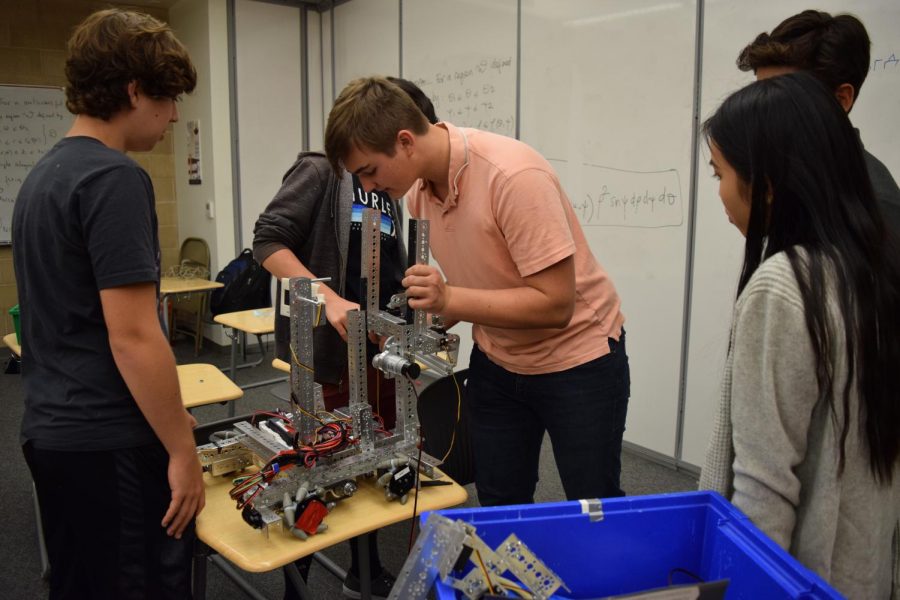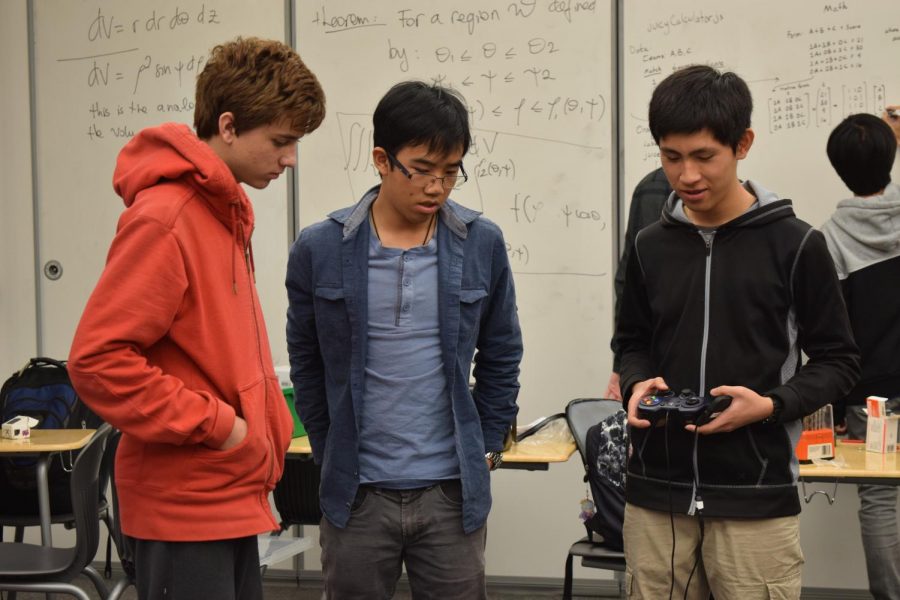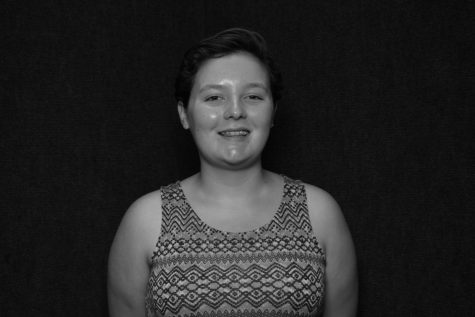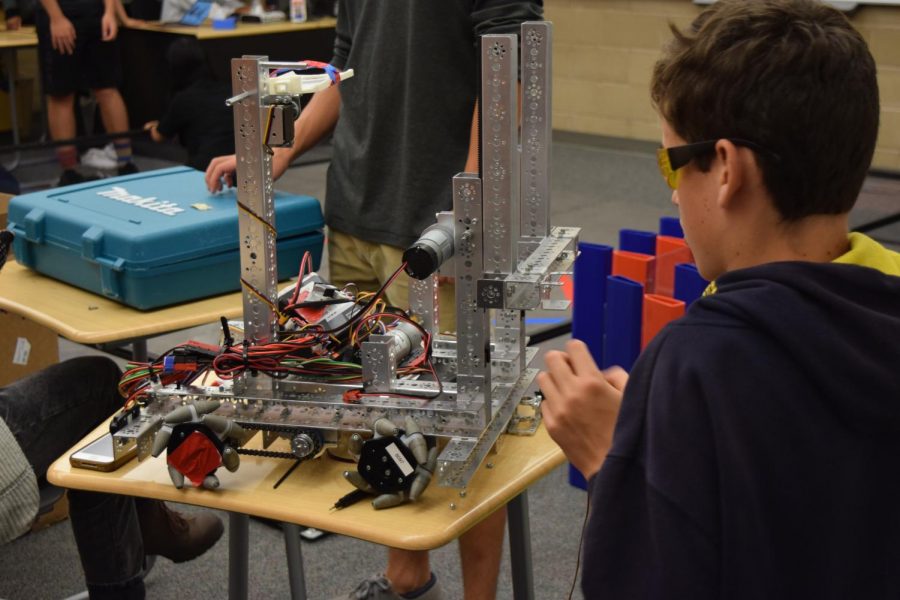Building Robots and Lifelong Skills
Robotics team member constructs for a future competition.
Despite the common misconception, Robotics Club isn’t just for programmers and engineers. It is for designers and dreamers; business managers and builders; team workers and fun seekers. This extremely versatile club represents one of the many ways Sage Creek students can explore their interests in STEM (science, technology, engineering and math) subjects while having a good time.
The club was founded in the school’s opening year by Sage Creek alumna Mitha Senthilkumar. She assembled a robotics team with the help of friends and old middle school robotics team members. They all worked together to get a club established through the district.
“I started the club at Sage Creek High School,” Senthilkumar said. “I formed a team of some kids that I’d done robotics with in middle school and some of my friends that had interest in it in ninth grade as well. We researched a lot about what to do, we talked to the program coordinator for the district and then we set up the club within the school and got it started.”
Senthilkumar explained the club’s original goal to teach students engineering skills and how to collaborate with others in a team while having a good time. The club has roots in programming and engineering.
“[The purpose of the club] is to give students the opportunity to learn about certain things in the engineering field and work as a team [and] to have fun and to learn while they are doing it,” Senthilkumar said, “It has a lot to do with software, hardware, and of course, business.”
Robotics has been a part of Senthilkumar’s life for a long time, as she has been interested in the field since the fifth grade.
“In fifth grade, I took a class with the robotics coordinator of the district [at the time] and I really liked it, so I kept talking to her and she helped me learn more robotics and I eventually joined a team in middle school,” Senthilkumar said.
Even now in college, Senthilkumar remembers adrenaline-filled moments from her time in the club, such as one competition where the team had to use quick thinking to fix a malfunctioning robot built from peculiar materials.
“The moment I remember the most is probably sophomore year or junior year, when our robot was built with a lot of cardboard and duct tape,” Senthilkumar said, “Our robot broke down at competition, so we drilled a hole shooting mechanism with cardboard and it actually worked. At that time it was really stressful, but when I think about it now it’s actually amusing.”
The club was not always smooth sailing; Senthilkumar mentions that it took a while for the club to grow into what it is now. She reveals that the club had to build its own structure and learn as they went on, particularly in the area of working together as a team. However, obstacles were overcome and the club is now stronger than ever.
“As a club, I think it was growing to become as big as it is now and to have the structure we have now that was the main problem; we didn’t have a structure at first and when we had to do things we would just rush into everything,” Senthilkumar said, “But now as a team, they work together really well and when I was on the team last year it was very organized compared to the other years and we overcame the issue and got farther than the previous three years.”
After Senthilkumar’s departure from Sage Creek, the club has remained relevant and thriving.
Current Robotics Club president junior Danylo Drogobytsky dove into an in-depth description of his position’s responsibilities, including communicating with the Carlsbad Educational Foundation (CEF).

“As club president, you are doing more logistical kind of things such as speaking with our manager or the people of CEF to work with ordering things,” Drogobytsky said, “You are trying to get the club up to date and keep them organized in terms of meetings, competitions, stuff like that.”
Drogobytsky is one of the team captains for the Robotics Team. He clarified exactly what is expected of a team captain in relation to other team members and their personal robotics goals as a team. The team captain is expected to lead the team in direction of this goal, while dealing with other aspects of robotics like ordering food and shirts
“I am also [one of the] the team captains … Team 8097 ‘Botcats,’” Drogobytsky said, “A lot of the responsibilities falls on team captains. There is three of them for [each of the] three teams and as team captain, you focus on … the overarching goal of the team and [work] with … specific groups of people.”
The team captain is also responsible for ordering materials.
“[You also have to deal] with the logistical things: the food, the t-shirts, the materials,” Drogobytsky said.
Drogobytsky provided information on the background of the Sage Creek Robotics Club and Teams and the program that they are involved in. The program helps students develop useful skills in both working with a team and working with engineering.
“Sage Creek Robotics Club and Teams are a part of FIRST Robotics Competition (FRC). FIRST is [a] program that promotes STEM,” Drogobytsky said.
The program helps students develop useful skills in both working with a team and working with engineering.
“Not only do they expose people to STEM, they also teach them valuable skills in technology and teamwork, which is of course is very important, because you’re … working in a true team environment to solve an actual [robotics] problem,” Drogobytsky said.
Similar to Senthilkumar, Drogobytsky’s passion for robotics can be traced back to the fifth grade with the FIRST LEGO League program (FLL).
“So I’ve been a part of FIRST robotics for a long time, I actually started all the way back in fifth grade, on the FIRST LEGO League Roboloution team at Aviara Oaks Middle School,” Drogobytsky said.
He credits the focus robotics puts on solving actual problems as one of the characteristics that caught his attention and kept him in the program for so long.
“It was always just amazing to have an actual problem that you are working to solve and I’ve been hooked ever since. So I’ve been on FLL teams for three years and I got to mentor some teams in eighth grade [during] summer and now I’m a part of FIRST Tech Challenge (FTC),” Drogobytsky said.
Drogobytsky explained how the program he became involved in helped him nurture effective skills and gain experience in passing on these skills to younger generations as a mentor.
“Throughout this time in FIRST, they really placed an emphasis on talking to the community and being a part of it and teaching people under you, so I have taught and been a co-coach to FLL teams and this has been a good experience because not only do I have the experience of working in a team from just being part of a FIRST team, I also now have an experience with teaching children and working with adults,” Drogobytsky said.
The club president loves the adrenaline of competition and mentions the way everyone works together like a well-oiled machine.
“[The club is] lots of fun,” Drogobytsky said, “There is always the kind of rushing before the competition where you are all working together and it’s amazing to see how everyone falls into their roles and finds what they like doing and the last week before competition everyone is working really diligently and super intense and excited about what they are doing.”
One of Drogobytsky’s favorite things about being a part of the robotics team is watching everyone figure out what part they want to play in the team and working together to create a finished, working product.
“[I enjoy] really watching everyone fall into their own roles and work as a team because you see how much more powerful a group of people can be working on a robot,” Drogobytsky said.
Like anything else, the team has faced some struggles, and Drogobytsky shares a memory of a prominent problem the team worked together on. Although it took time and effort, the team came out on top, stronger for overcoming this issue.
“There was a problem last year when we had a different electronic system where some wires would seem to disconnect, but we did not know this just from moving around,” Drogobytsky said, “We actually assumed this was static, because when you move the robot and it stops after that, the robot would stop and if you bump into something with the robot it would also stop, so we assumed we were still building static discharge and the discharge may kill the robot. So we had this problem that was completely debilitating and preventing the robot from moving, obviously a vital part of a robotics competition, so we had to have the team work through hours and hours of different parts of the robot to see what was there. That was a pretty big problem, but we did get to solve it.”
Drogobytsky opens up the Robotics club to any and all students.
“Honestly, any kind of student [should join this club]. It is a really, really versatile club. There can be this kind of taboo that you have to do programming or have to like building robots to be in robotics, but it’s not like that,” Drogobytsky said, “There is a business side of robotics [and it] is one of the more important parts of winning a competition or winning a trophy.”
A student does not have to come from a robotics background to become successful in the club, as proven by senior Andrew Liang, who originally joined the club to be around friends.
“Originally, I didn’t really know what I was doing [in the club]; I just showed up because I had a ton of friends going to that club and they said ‘you should join,’ and once we went to the first competition, that was really, really great so I decided to stick around,” Liang said.

Andrew Liang (middle) and other members control a robot in preparation for competition.
Liang has climbed up the ladder in the club and now hold the title of designer for one of the teams. As a designer, he chooses the appearance of the robot.
“I work as the designer on one of the teams, so, what I usually do is I’ll decide how the robot going to look and I’ll share it with team. Then I’ll help them work together and come up with a solution to try and build it,” Liang said.
Robotics competitions are a day-long event, from about 6:30 in the morning to 5 in the afternoon and, according to Liang, can involve up to thirty teams. Teams play in elimination matches and are judged for awards at the end of the day.
“Usually you will wake up at around 6:30 and then head down to a venue where there is about 10 or 15 other teams — sometimes even 3- — and you’ll compete for an entire day, matched up against two other teams,” Liang said, “You’ll play a ton of elimination matches and the highest score at the end of the day — as well as some judged award — and that usually lasts until 4:30 or 5 in the afternoon.”
The robotics club has been quite accomplished at these competitions, winning some recognition.
“At the county level, we’ve won a couple recognitions for our engineering process … as well as some design awards because some of our robots are really well built,” Liang said.
Although everyone may not always get along, the team embraces cooperation and encourages members to listen to each other’s ideas, which usually leads to a happy ending.
“Sometimes when you come up with an idea, other people may not always like it, so there’s usually a lot of discussion and sometimes debate over who wants to do what and how it should be done,” Liang said. “Usually you work through it by finding the good points in both of them and putting them together and see which one works out because there is a lot of testing.”
A key aspect of robotics that has kept Liang interested all the way through his high school career is the satisfaction of watching the team flourish. They can start out as a big organized mess and end up creating a working robot while creating friendships and learning skills.
“I think watching our team grow [is my favorite part] because once you watch people learn how to do stuff, it goes from a bunch of clowns running around throwing things to some really crazy-looking professional team that has a robot that you didn’t know was possible four years ago,” Liang said.
As articulated by club founder Mitha Senthilkumar, robotics club can be a great experience for all kinds of people, no matter their pasts or futures.
“The club is a club for anyone because there are so many different aspects of robotics that people don’t notice, besides software and hardware—building and stuff—not everyone likes doing those kinds of things, but there’s always marketing; we do make videos for the club. If people are into that, there is a lot of design, modeling and things like that,” Senthilkumar said, ”Anyone that thinks they like that kind of thing, or just one aspect of it, they can join and we’ll find a place for you.”
For a student looking to make high school memories of their own while learning new skills, the robotics club can be found at school on Wednesdays from 6:30 to 8:30 in the evening or on Mondays after school until 4:30.

Amanda is a senior and this is her first year as a journalist, contributing to The Sage through writing and photography. Amanda loves nature, stupid jokes,...

Reilly is a senior at Sage Creek High School and staff reporter for The Sage. Her other interests include photography, music, dogs, and hanging out with...



Charlie Lewis ◊ Dec 20, 2017 at 2:10 pm
Go Crow Force 5! :3